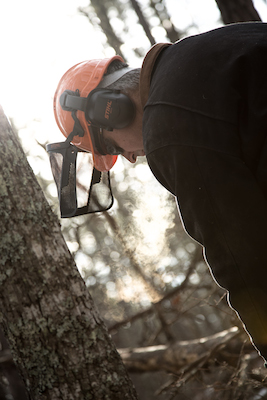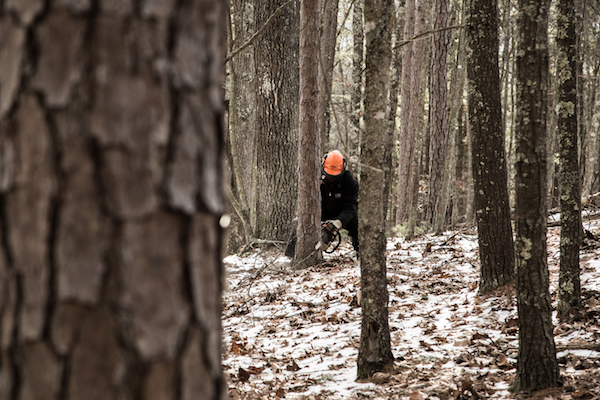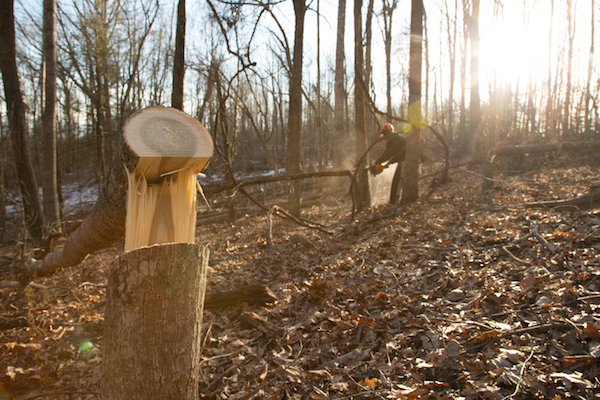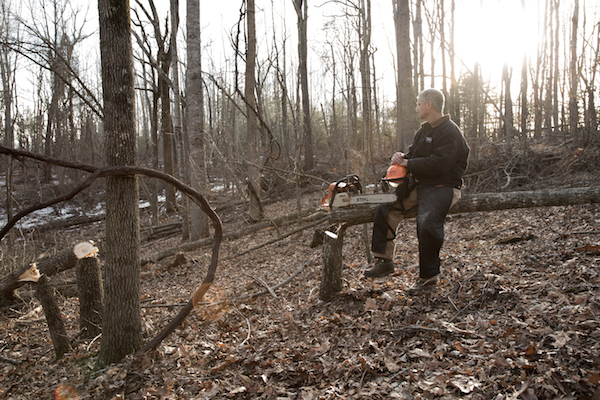LAST UPDATED: May 1st, 2015
In part 1 of this this 2-part series on hinge cutting, I discussed the immediate and long term benefits that hinge cutting can have as part of your deer management program. However, as much fun as it is running a chainsaw thinking of how you’re feeding deer and giving them added cover, it’s arguably even more fun running a chainsaw imagining how you’re improving your bowhunting opportunities during the fall! In this post, I’m going to outline 4 hinge cutting tips and ideas that you can do now, to improve your hunting this fall. Let’s fire up the saw!
A chainsaw can be a deer manager’s best friend this time of year. All it takes is a little hard work and creativity. Here, my dad’s effort is exemplified by the vapor trail created by the cool winter air.
Put ‘em Where You Want
It’s no secret that the go to strategy for many of the most successful bowhunters across the country, is to find a funnel between food sources and bedding areas, hunt it with the right wind, and wait for a mature buck to make a mistake. It’s a slam-dunk strategy, and funnels are where many big bucks meet their maker each fall. But, what’s a bowhunter to do when he hunts a property where funnels aren’t as pronounced or, worse yet, non-existent? He creates them himself, that’s what he does!
Building a funnel with hinge cuts really is as simple as it sounds. You’re simply building a deer highway by hinge cutting trees on either side of the highway. There’s some debate about how wide your funnel should be, but I like mine to be around 15-20 feet. This gives deer plenty of space to freely maneuver through the funnel, but it’s not so tight that they feel trapped or have to walk through in single file.
Also, keep in mind when you’re hinging the trees, NOT to let them fall parallel to the trail. It would seem you like you’d want the trees to fall parallel with the trail to keep the deer from “escaping” the funnel, but it’s actually the complete opposite. Instead, cut the majority of the trees so they fall perpendicular to the trail. Again, you don’t want the deer to feel trapped in the funnel. Deer are rather lazy creatures and if you provide them with an open space with adequate cover on each to travel through, they’re going to use that trail. However, deer need to have escape routes if need be. Plus, you’re funnel should be leading to a bedding area or food source anyway, so it’s not likely they’ll have much reason to jump ship. After all, you’re hunting wild deer, not herding cattle onto a semi.
Creating a deer highway through thick timber by funneling deer with your hinge cuts is a great way to increase bowhunting opportunities.
Building Bedding Areas
I’ve been very fortunate over the last several years to visit a number of different deer hunting properties in several different states across the Midwest and in my home state of Virginia. The common theme I’ve found on the premiere properties I’ve visited is that they all have mature bucks spending the majority of their time on that property. How is that accomplished? Strategically placed bedding areas.
There’s always a rhyme and reason as to why mature bucks do what they do, and why they bed where they bed is no exception. Scouting out a certain location that has favorable traits for a buck bedding area, and then hinging that location, is an easy way to keep bucks on your property longer. Look for an area that has a good vantage point, keeping in mind that bucks like to bed high in the morning while using the thermals to their advantage, with good escape routes. When building bedding areas, I tend to be a little more liberal with the trees I cut. As mentioned in part 1 of this series, hickories and oaks hold their leaves well into the fall, and hinging a few of those trees can go along way in providing the extra cover mature bucks love.
Deer, especially mature bucks, like to bed high on ridge and hilltops that have a good vantage point in the morning. Keep this in mind when creating bedding areas.
Edge Feathering
If you’ve read much whitetail literature in your hunting career, then you’ve surely read that whitetails are creatures of edge. That’s a completely true statement, and it’s quite clear as to why the best whitetail habitat IS edge habitat. In other words, edge habitat is where the habitat gradually changes from one ecotype to the other.
Deer love feathered field edges especially because of the safety and cover it provides. It creates a natural transition area that deer will feel comfortable staging in before they enter the field. Hinge cutting trees from the field edge back into the timber will increase the likelihood of a mature buck using the field or food plot during daylight hours. A hinge cut funnel through the edge habitat will allow you to hunt back off the plot in the timber, allowing you to get down from your stand in the afternoon without blowing deer out of the plot. Keep this in mind when designing and creating your food plots this winter!
Visual Barrier
Just as easily as you can build a funnel to put deer where you want them to be while you’re in the stand, you can hinge cut trees to build a visual barrier to keep them from knowing you’re there!
When I’m scouting out a location for a potential stand site, I first determine if I can access and leave the stand undetected before I remotely consider hanging a stand there. If you’re educating deer going to or from your stand, you’ve already lost the battle.
Fortunately, though, by hinge cutting trees in strategic locations you can hide your entrance and exit routes allowing you to access your stands undetected. When hinging trees in this type of situation, I like to make my cuts a little bit higher, because I want the horizontal cover to block all of my movements. The tree’s new growth during the spring and summer will also help. You can also hinge cut trees around your property line to discourage trespassers or poachers from sneaking a peak, or worse yet, taking a shot onto your land.
This time of year is perfect for improving deer habitat and creating better hunting opportunities. There are few feelings that top a day of running a chainsaw knowing you’ve done both!
By now I’m hoping you’ve realized two things. One, I’m extremely passionate about the habitat and hunting improvements hinge cutting can so easily provide. And two, you can do them just as easily and it costs you next to nothing!
As I mentioned in hinge cutting 101, the effectiveness of your hinge cutting is limited only by your own creativity and how hard you’re willing to work. So, with that being said, gas up your saw, throw on your safety gear, and a have a blast improving the overall makeup of your hunting property (safely of course)!










